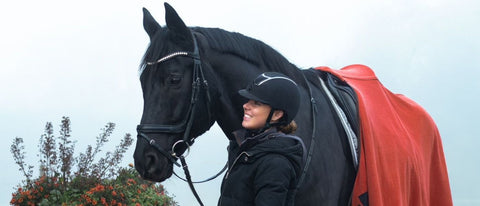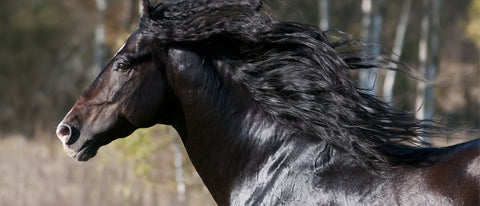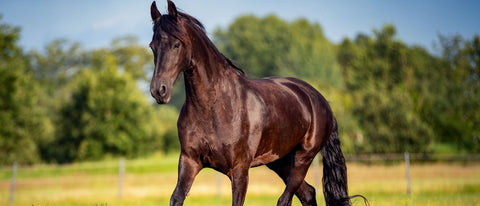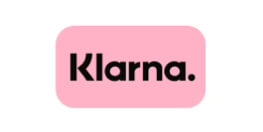
Florian ist aufgewachsen auf einem Bauernhof. Umgeben von Pferden, entdeckte er früh seine Faszination für diese majestätischen Tiere. Inspiriert von seiner reitbegeisterten Mutter, entwickelte er das Nahrungsergänzungmittel - Pferdegold. Seine tiefe Verbundenheit zur Natur und die leidenschaftliche Hingabe zu Pferden trieben ihn an, sein Unternehmen zu gründen.
Dressage riding is the foundation of all riding styles and contributes significantly to the horse's strength, mobility, and health. The training scale—consisting of rhythm, looseness, contact, momentum, straightness, and collection—forms the foundation for a harmonious connection between horse and rider.
With different dressage classes, from beginners (E) to advanced classes (S), every rider can individually adapt their training and develop it further.
What is dressage riding?
Dressage riding is much more than just riding in a circle. The foundation of dressage is aimed at improving the horse's natural movement patterns. The focus is on the harmonious cooperation between horse and rider .
Through targeted exercises, not only physical fitness and flexibility are strengthened, but also the communication between horse and human is intensified.
The Scale of Education: The Key to Harmony
The foundation of every successful dressage training is the scale of training .
This scale comprises six consecutive points:
- Rhythm: Uniformity and regularity of steps in all gaits.
- Relaxation: Relaxation of the horse, which avoids unnecessary tension.
- Contact: Fine, even contact between rider and horse to stabilize the connection.
- Momentum: elasticity and joy of movement, which enables dynamic and powerful gaits.
- Straightening: Equal loading of both sides of the body in order to ride the horse symmetrically.
- Collection: Shifting body mass to improve strength, balance, and control.
The coordinated implementation of these points leads to a supple and harmonious horse that is ready for more demanding lessons.

Perfect for your horse: Pferdegold® supplementary feed!
These specially developed supplements support your horse's diet and provide it with natural nutrients. Made in Germany, grain-free and drug-free, they come with a 30-day money-back guarantee.
Try it now!Dressage classes: From beginners to professionals
To accommodate the different levels of training of horse and rider, there are several classes in dressage:
- Beginner classes (E and A): The foundation of dressage riding. Fundamental skills such as simple track figures and the transition between the basic gaits of walk, trot, and canter are taught here.
- Light Class (L): In this class, the demands are increased. Movements such as shoulder-in, travers, collected trot, and canter are introduced.
- Intermediate Class (M): More complex movements such as series changes and more demanding track figures require precise communication and coordination.
- Advanced Class (S): The highest national level, which requires advanced movements such as piaffe, passage and even pirouettes.
Choosing the right class depends on individual progress and goals.
Dressage training - how you can improve
Successful dressage training is based
- in a safe seat,
- clear assistance
- and understanding the horse's natural movement patterns.
It's important to combine theory and practice . Regular training and continuous education help keep track of progress.
The right seat: The foundation for successful riding
A stable, balanced seat enables the rider to deliver precise aids. It forms the foundation without which none of the other techniques can function.
Giving aids: How to communicate with your horse
Communication occurs primarily through subtle aids using weight, leg, and reins. Harmonious, coordinated aid application ensures clear signals and prevents misunderstandings.
Understanding the horse: anatomy and movement sequences
A sound knowledge of the horse's anatomy and its natural movement patterns not only improves the implementation of dressage lessons but also helps to avoid possible overloads and injuries.
Lightness and harmony: The goal of dressage riding
The overarching goal of dressage riding is to achieve lightness and harmony between horse and rider.
This is particularly successful with approaches such as the "School of Légèreté" and structured riding lessons in which clear priorities are set.
Riders who internalize this approach experience a significant improvement in the execution of the lessons.
Is dressage riding good for horses?
Well-executed dressage riding not only strengthens the horse's muscles but also promotes its overall health . Targeted movement sequences improve balance and minimize the risk of injury , provided that excessive strain is avoided.
Yes, dressage riding is good for horses because it supports the natural development of the horse's body and ensures balanced exercise. However, the horse's individual constitution should always be taken into account.
Competition riding: tests and evaluation
Ambitious dressage riders have the opportunity to demonstrate their skills in competitions. In these competitions , horse and rider are assessed based on
- the training scale,
- the quality of the gears
- and the overall impression.
Aids and equipment in dressage riding
Special equipment such as
- Saddle,
- bridle,
- whip
- and spurs are important companions in dressage riding.
It should be noted that some aids are only approved in certain classes and should always comply with current safety standards.
Mental aspects in dressage riding
In addition to physical training, mental strength is of great importance.
- Concentration,
- patience
- and the trust between horse and rider are essential components to successfully master the complex lessons.
Current trends and developments in dressage riding
The world of dressage is constantly changing – modern training methods, insights from horse behavior research, and an increased focus on animal welfare are shaping the future of this discipline.
New training approaches and technical innovations are helping to make dressage riding more modern and, at the same time, more species-appropriate.
Conclusion
In summary, dressage riding goes far beyond pure technique. It's about building a deep, harmonious connection between horse and rider, which is nurtured both physically and mentally. Whether during training, competitions, or everyday riding – the right equipment, a secure seat, and precise aids are the cornerstones of successful training.
FAQ
What is the difference between dressage and show jumping?
Dressage riding focuses on gymnastics and harmonious execution of movements, while show jumping also requires overcoming obstacles.
Which dressage class is right for me?
The decision depends on your horse's level of training and your own ability. Ideally, start in the beginner classes (E) and progress as your skills increase.
How often should I ride dressage?
Regularity is important, but recovery phases should also be planned to avoid overload.
Is dressage riding suitable for every horse?
In principle, yes – however, it is advisable to take the horse’s physical condition and age into account.
What are the most important lessons in dressage?
The central lessons include the basic gaits (walk, trot, canter), lateral movements such as shoulder-in and travers, as well as collection lessons (piaffe, passage).
Important:
Pferdegold is not a substitute for veterinary diagnosis or treatment. The information contained in this article is for general informational purposes only and is intended to help improve your horse's well-being.
Pferdegold products do not treat or cure diseases, but rather support your horse in compensating for nutritional deficiencies through targeted nutrient intake.
However, they are not a substitute for professional advice from a veterinarian or specialist. If your horse has any health problems, we strongly recommend consulting a veterinarian. Pferdegold assumes no liability for decisions made based on the information provided here.
🐴 Would you like to read more about horse training:

















